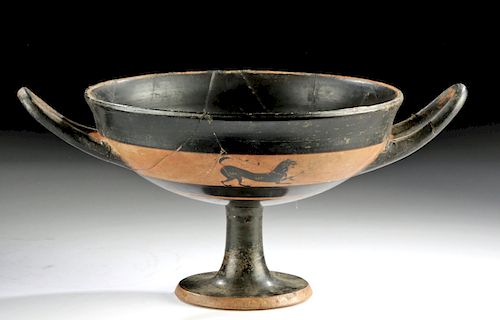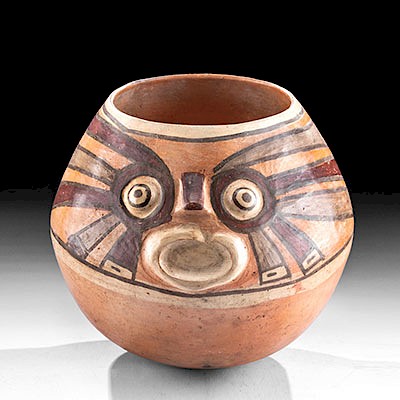Greek Attic Black-Figure Stemmed Lip Cup w/ Lions
Lot 11c
About Seller
Artemis Gallery
686 S Taylor Ave, Ste 106
Louisville, CO 80027
United States
Selling antiquities, ancient and ethnographic art online since 1993, Artemis Gallery specializes in Classical Antiquities (Egyptian, Greek, Roman, Near Eastern), Asian, Pre-Columbian, African / Tribal / Oceanographic art. Our extensive inventory includes pottery, stone, metal, wood, glass and textil...Read more
Categories
Estimate:
$2,500 - $3,000
Absentee vs Live bid
Two ways to bid:
- Leave a max absentee bid and the platform will bid on your behalf up to your maximum bid during the live auction.
- Bid live during the auction and your bids will be submitted real-time to the auctioneer.
Bid Increments
| Price | Bid Increment |
|---|---|
| $0 | $25 |
| $300 | $50 |
| $1,000 | $100 |
| $2,000 | $250 |
| $5,000 | $500 |
| $10,000 | $1,000 |
| $20,000 | $2,500 |
| $50,000 | $5,000 |
| $100,000 | $10,000 |
| $200,000 | $20,000 |
About Auction
By Artemis Gallery
Dec 5, 2019
Set Reminder
2019-12-05 10:00:00
2019-12-05 10:00:00
America/New_York
Bidsquare
Bidsquare : Ancient / Ethnographic - Holiday Edition
https://www.bidsquare.com/auctions/artemis-gallery/ancient-ethnographic---holiday-edition-4710
What to give this holiday season? Ancient & Ethnographic Art of course! Our special Holiday auction features hundreds of unique finds from all over the world. Artemis Gallery info@artemisgallery.com
What to give this holiday season? Ancient & Ethnographic Art of course! Our special Holiday auction features hundreds of unique finds from all over the world. Artemis Gallery info@artemisgallery.com
- Lot Description
Ancient Greece, Athens, Attic, ca. 5th century BCE. A beautiful wheel-thrown Attic lip cup - a form of kylix - with a hemispherical body, a thick rim, and a pair of projecting parabolic handles, all atop a slender stem and discoid foot. Lustrous jet-black glaze envelops many areas of the vessel, though reserved areas of the foot, body, and central basin provide for a bi-chrome schema. The reserved band on the exterior displays a pair of stylized lions with incised striations that delineate their muscular bodies, powerful claws, sinuous tails, and full manes. One lion still retains its original black pigmentation, though the viewer can still visualize the second lion based on the remaining incised details. A concentric circle adorns the tondo, as is customary for Attic-ware. Lip cups were somewhat difficult to produce, and the pronounced ridge underneath the rim of lip cups would have prevented spillage. Size: 7.875" W x 3.7" H (20 cm x 9.4 cm).
This piece presents strong Attic black-figure painting technique. The artist first painted with slipware and then carefully scratched into it with a type of needle in order to incise the lines, thus creating delightful figures and patterns. In this case, the artist has depicted lions, an ancient symbol of fierceness and power, as well as favored items to be hunted.
For a stylistically-similar example depicting a ram, please see The British Museum, museum number 1886,0401.1290: https://www.britishmuseum.org/research/collection_online/collection_object_details.aspx?objectId=459336&partId=1
Provenance: private Alabama, USA collection; ex-Roy Green collection aquired prior to 2013
All items legal to buy/sell under U.S. Statute covering cultural patrimony Code 2600, CHAPTER 14, and are guaranteed to be as described or your money back.
A Certificate of Authenticity will accompany all winning bids.
We ship worldwide and handle all shipping in-house for your convenience.
#148745Repaired from multiple pieces, with restoration, resurfacing, and overpainting along break lines. Minor nicks to rim, foot, and handles, with fading to areas of original pigmentation, and light softening to some incised details. Nice earthen deposits and traces of original glaze color throughout.Condition
- Shipping Info
-
All shipping is handled in-house for your convenience. Your invoice from Artemis Gallery will include shipping calculation instructions. If in doubt, please inquire BEFORE bidding for estimated shipping costs for individual items.
-
- Buyer's Premium



 EUR
EUR CAD
CAD AUD
AUD GBP
GBP MXN
MXN HKD
HKD CNY
CNY MYR
MYR SEK
SEK SGD
SGD CHF
CHF THB
THB
















